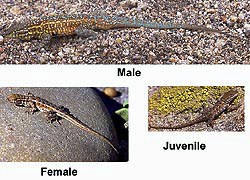|
Common Name: Side Blotched Lizard Scientific Name: Uta stansburiana Habitat: Shrub-steppe habitats, sandy or rocky soil that has scattered brush or trees. Size: 2.5 inches (6 cm) Diet: Opportunistic feeder, generally eats insects and arthropods (spiders, scorpions, etc.) Predators: Snakes, birds, and larger lizards 
NPS Behavior: These lizards are often seen on the ground at the edge or under shrubs or other vegetation that provides cover from larger predators. During the heat of the day, rainy periods, or cooler periods, they retreat underground or move under cover such as rocks, trees, or other woody debris. Conservation: The Side-blotched lizard is moderately sensitive to climate changes. Their habitat, the shrub-steppe, are sensitive to altered fire patterns as well as invasive weeds such as cheatgrass. The disappearance of their habitat as well as warmer temperatures could cause disruptions to their breeding cycles as well as regulating their temperatures, leading to a decrease in the lizard population. When to See: Often seen at Bryce Canyon during the summer, the Side-blotched lizard emerges around April and will retreat from the cooler weather in September or October. They are most active during the spring and fall and tend to hide from the heat during hot summer days. |
Last updated: August 26, 2024
